2023 Agency Insights Report
Continue reading below for data-driven insights and analysis to help you navigate the shifting landscape and level-set with the competition.
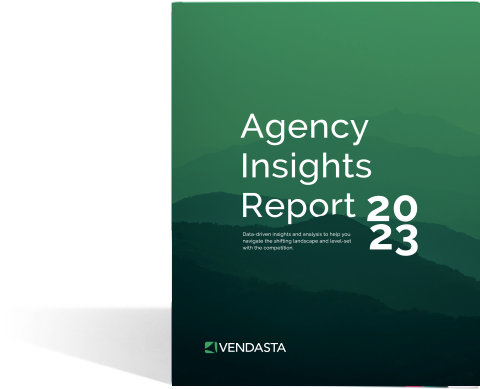
Keep reading for an analysis of the latest digital marketing agency statistics:
- Biggest growth challenges, operational pain points, and strategies to address them
- Most effective sales channels for closing new business
- What agencies making over $1 million in annual revenue are doing differently to thrive in a saturated market
- Agency benchmarks including churn rates, average annual revenue per client, service offering profitability, AI adoption, and more
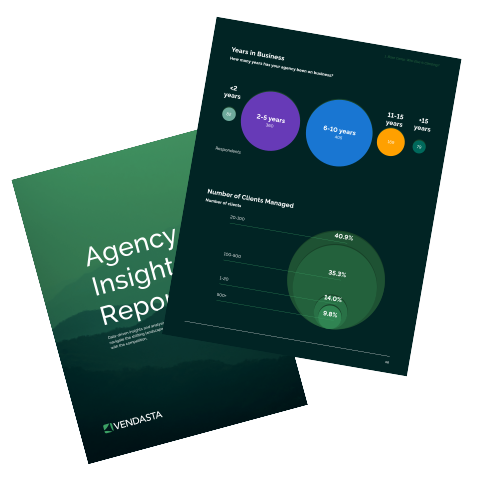
Foreword from Jacqueline Cook, COO of Vendasta
Welcome to the 2023 Agency Insights Report! As COO of Vendasta, I am thrilled to present our findings and takeaways to help guide you on your agency’s growth journey.
In the past year, we’ve seen major changes in the way agencies operate, with agencies of all sizes finding themselves at a crossroads. But it’s an exciting time to be on this journey, too.
One thing our research shows is that, despite all the advancements in tools and technology, the basics matter more than ever. Focusing on customers and their problems, building deeper and more sustainable client relationships, and finding time to do more of the work you love and are excellent at—these are the keys to success.
I hope you use these agency benchmarks as a compass to help you scale the next summit and make meaningful progress towards your agency’s goals.

Our Approach: Surveying the Agency Landscape
Agencies are facing disruption on multiple fronts in 2023, including the paradigm-shifting public access to artificial intelligence (AI), a looming economic downturn, changing consumer behaviors, and an increasingly saturated market.
It’s understandable, then, that agencies are especially keen to know the latest agency benchmarks and digital marketing agency statistics to see how they stack up compared to their peers and competitors in the current market.
Consider the rapid shift to digital and online business models post-2020. As the dust continues to settle on this new landscape, many small to medium-sized businesses find themselves unprepared to grow sustainably and adapt to the pace of technological innovation. It’s crucial for agencies to fulfill their role as a trusted guide—now more than ever.
Vendasta conducted a survey of agency professionals, including agency owners, CEOs, C-level executives, VP/directors, and managers, to gather up-to-date agency benchmarks on the current state of agencies and help you confidently stay the course and ascend to the next level.
With hundreds of responses to our anonymous survey, we’re able to provide a valuable snapshot of the industry. Of course, this number is still only a slice. It’s impossible to take in an entire mountain all at once—you’d have to zoom out pretty far to even try. This report is made better by its ability to zero in on the most relevant nuances and take some deeper dives into the data.
🏔 Base camp: Who else is climbing?
Contextual information is key for any agency benchmarks research report. With a pool of hundreds of respondents, you’re sure to see some variation—be it size, revenue, pain points, or operations. Here’s a little background on our participants.
- Entering ‘middle age’: 56% of agencies surveyed have been in business between two and 10 years—that’s more than startups (<2 years) and veterans (11+ years) combined.
- The million dollar threshold: More than half of agencies reported earnings of $1 million or less in 2022, highlighting the opportunity to increase revenue and expand.
- Quality over quantity: 22% of agencies with 3-10 staff members manage 100 clients or more.
- Bottom line: The route to success is less about the sheer volume of work or clients, and more about smart scaling strategies.
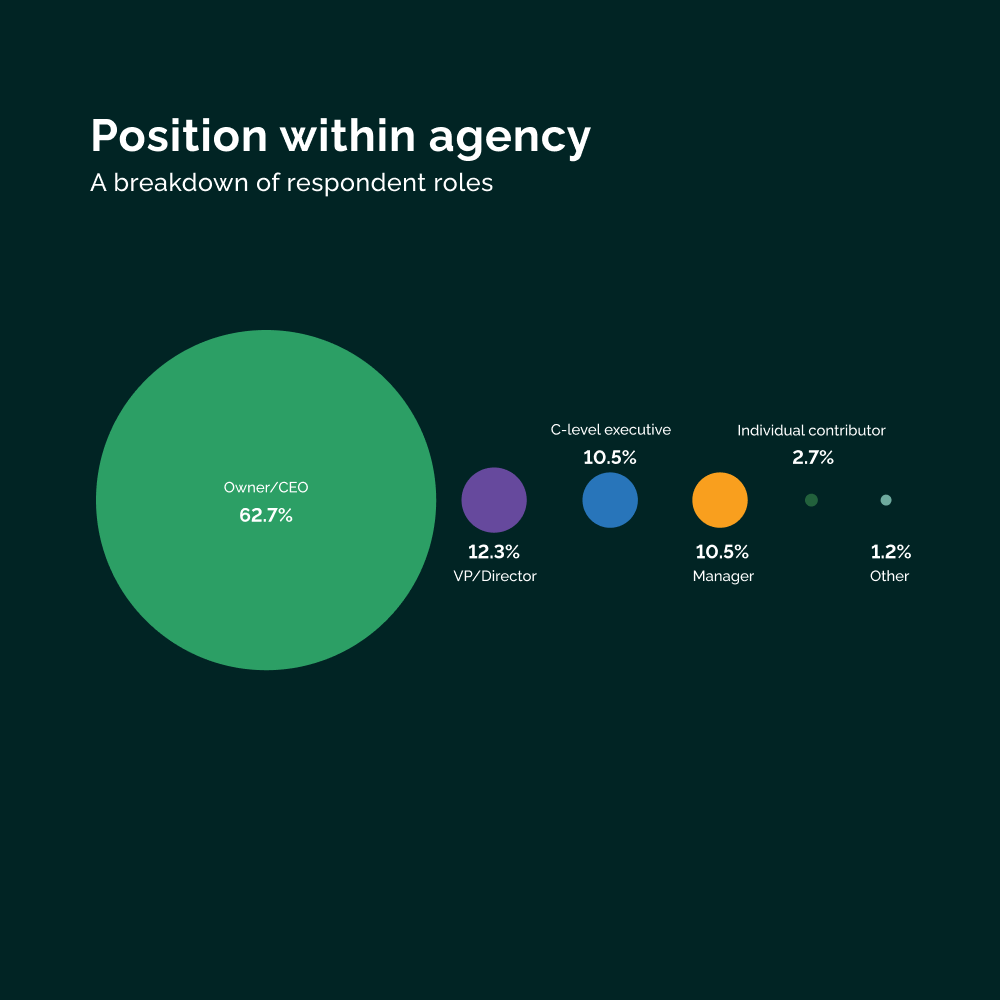
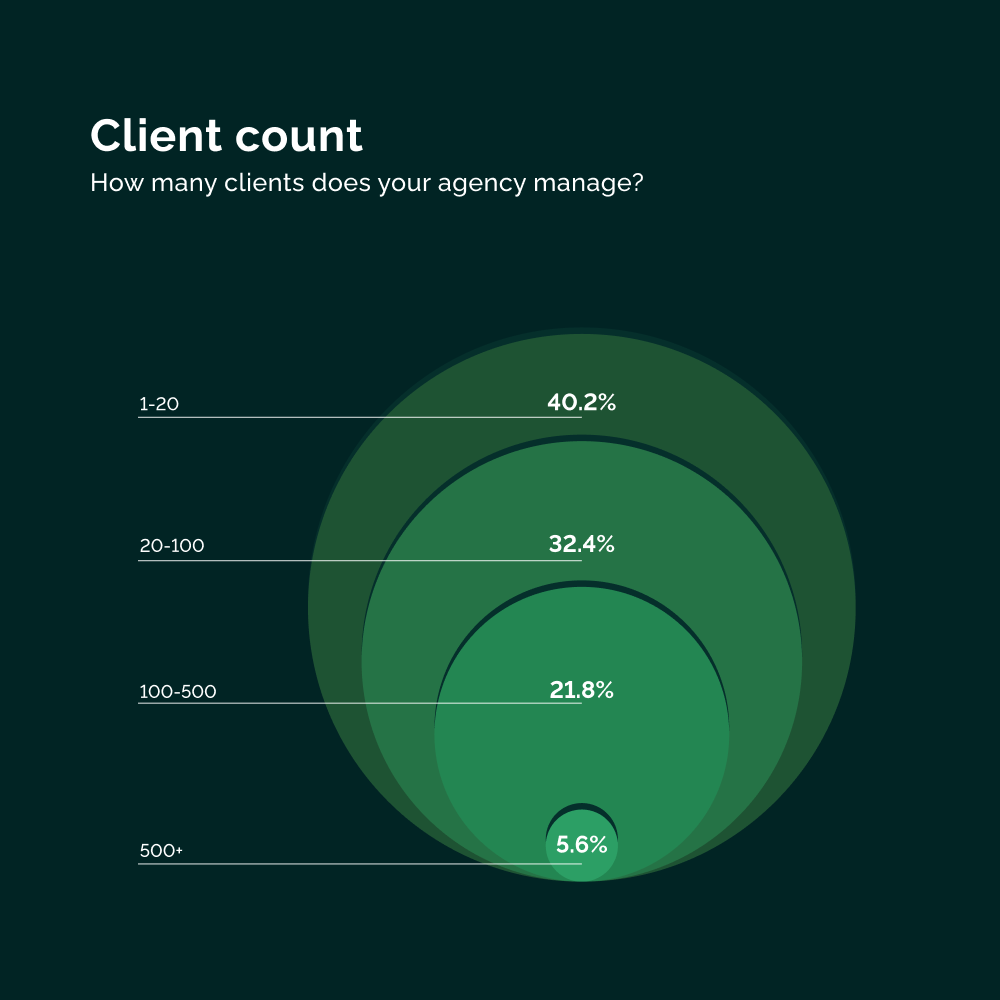
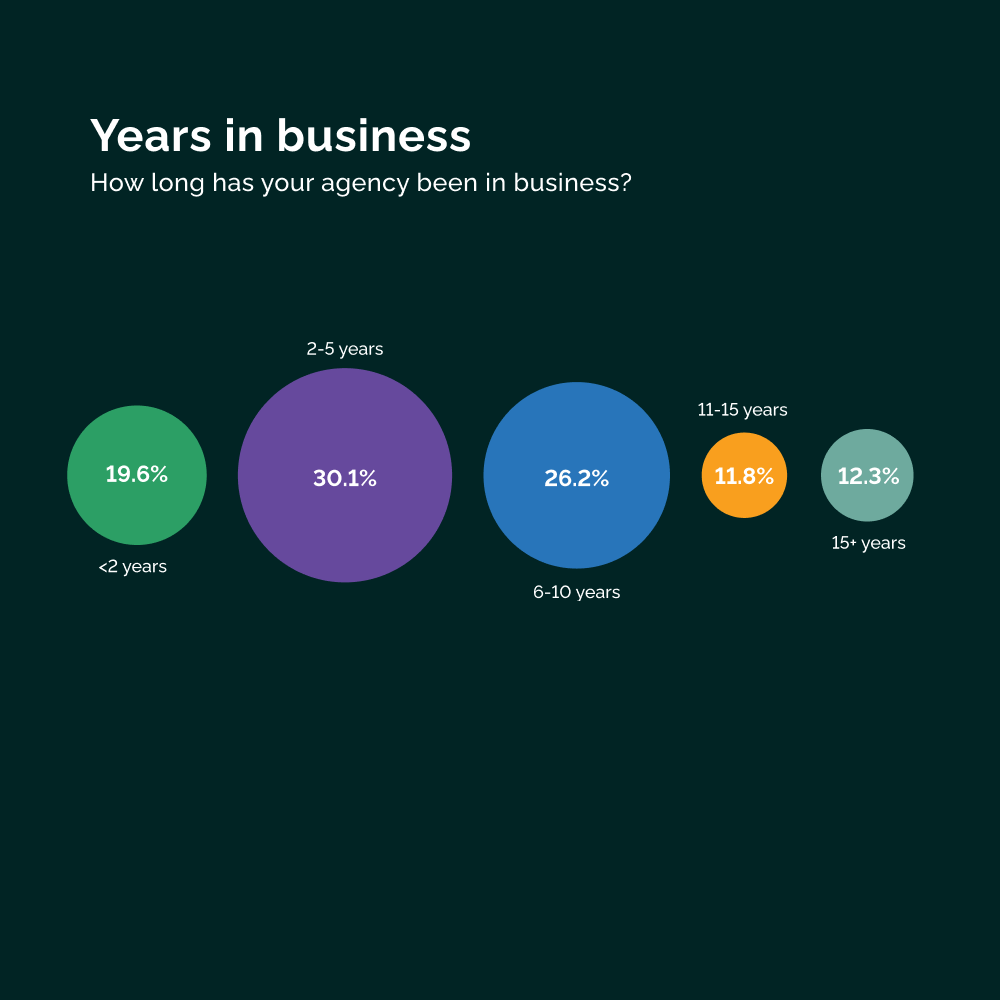
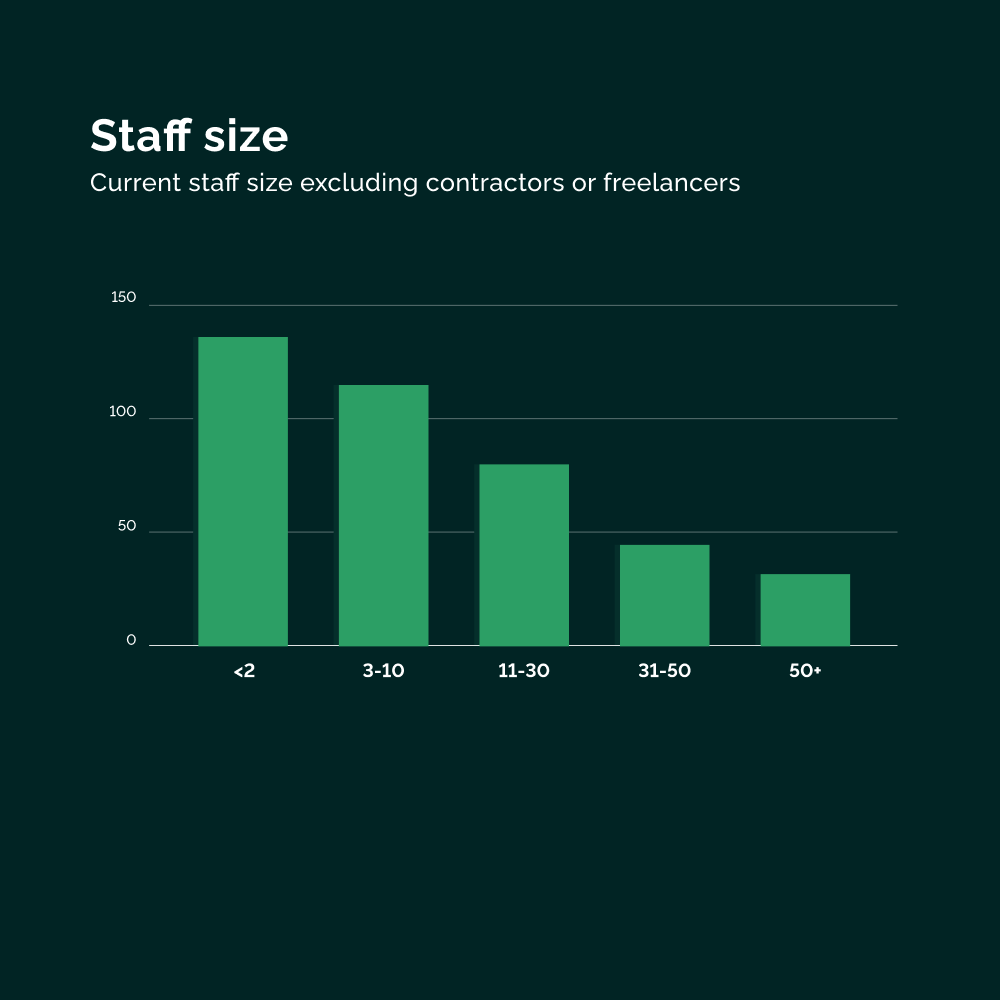
- Only 17% of agencies with two staff members or less can manage over 20 clients.
- One third of agencies with 3-10 staff members are handling well over that number; 22% of them are managing 100 accounts or more.
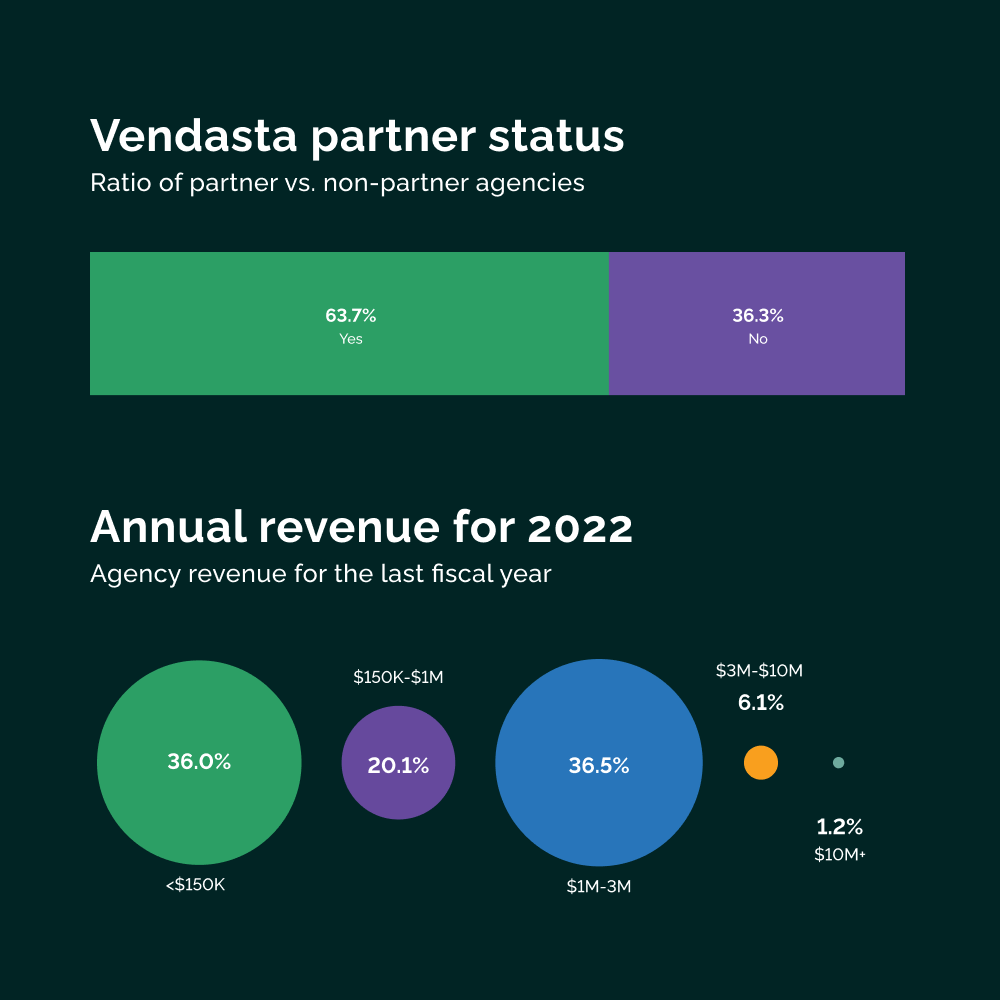
88% |
of agencies with annual revenue surpassing $1 million in 2022 reported an average revenue per client per year of $50K and above. |
Our analysis
According to our agency benchmarks, more than half of the agencies surveyed (56%) are navigating ‘middle age’, having been in business for two to 10 years. ‘Middle age’ is defined by new aches and pains for agencies who find themselves at a crucial crossroads: Scaling operations while preserving quality, retaining the agility of a startup as the team grows, and striving to establish a distinctive identity in a saturated market.
If these challenges can be met head-on, the financial landscape underscores huge potential for expansion. The majority of agencies surveyed reported earnings of $1 million or less in 2022, signaling that many are on the precipice of a crucial earning threshold. And moving beyond this marker can change the game. 88% of agencies who crossed the million-dollar threshold report an average annual revenue of $50K per client or more. This insight reveals that a winning strategy might be to focus on securing higher-value contracts, rather than just expanding client bases.
In the end, charting a thoughtful course through the competitive terrain is what distinguishes agencies who merely survive from those who thrive. The good news? Successful strategizing doesn’t require a big team. Data shows that a small team doesn’t limit an agency’s client capacity, with one caveat: The agency must have more than two employees. Solopreneurs and micro-agencies are likely to reach capacity at only 20 clients.
But moderately increase staff count to between 3-10 employees? 79% of these agencies are managing a roster beyond 20 clients, with 22% of them managing 100 clients or more. The route to success, therefore, seems to be less about the sheer volume of work and more about quality-driven, smart scaling strategies. These strategies might include leveraging fulfillment services for scaling client work, using automation and efficiency tools, and using one integrated platform for a single source of truth.
While it’s valuable to address longer-term challenges or risks to ensure future sustainability, pain points currently impacting day-to-day agency operations need immediate attention first. Once urgent obstacles are removed, the path forward is often more efficient and profitable. What is currently getting in the way of agency progress?
Become 7X more profitable than the average agency
Schedule a demo with Vendasta today to find out how.
SECTION TWO
🏔 Scouting the route: Identifying current challenges and strengths
In this section, we’ll explore the peaks and valleys of agency service offerings, as well as the most pressing pain points faced in day-to-day operations.
We’ll also tackle growth challenges, how churn rates impact an agency’s journey, and what to do about it in 2023 and beyond. Let’s lace up our boots and begin.
- Content is king, with a twist: Content remains a profitable service offering for most agencies, but the definition of ‘content’ has broadened in scope.
- Operational efficiency and profitability: Most agencies struggle with maintaining project profitability and margins.
- High revenue, high churn: Low client churn rates may not always be a good thing, especially if it means hanging onto low-paying clients.
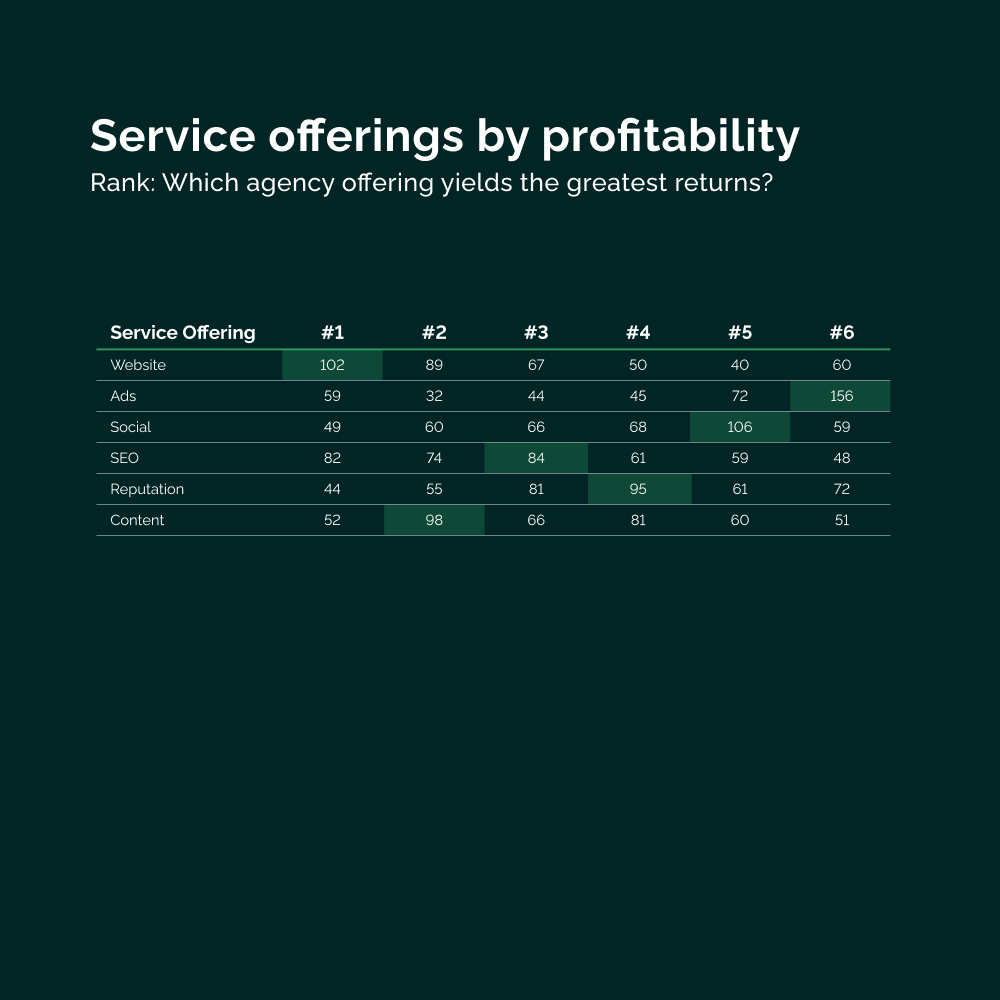
Determining which individual service offerings are most or least profitable depends on the specific agency, their niche, and their target market. More tactical elements such as pricing strategies and the freedom to control profit margins will also be contributing factors, as will whether agencies are fulfilling services in house or outsourcing (more on that later).
Key findings
25%
of agencies say websites are their most profitable service.
38%
of agencies agree paid ads are their least profitable service.
1/2
of agencies’ ranked content creation in their top 3 most profitable service offerings.
Deeper dive
38% of agencies are selling an average of 1 to 2 products per client.
💡 Pro Tip: Bundle service offerings
Increase revenue and present a stronger offering by creating digital marketing packages instead of selling individual solutions separately. You’ll sell more services while addressing the entire customer journey and deepening relationships with clients.
Recommended Reading: How to scale revenue by selling high-margin product and service bundles
Our analysis
According to our agency benchmarks, some things change, some stay the same. In this case, despite the rise of AI and other technologies, content still delivers consistent value, ranking among the top three most profitable services for over half of agencies. Websites still take the top spot as the most profitable service offering. But you know what a good website needs? Good content!
While content’s ongoing significance in the digital marketing landscape is clear, the rise of diverse forms of media means that agencies must redefine what content creation means. To leverage content properly, agencies must go beyond traditional blog posts and ebooks to include things like podcasts, long-form and short-form videos, and webinars, in their offerings.
Interestingly, 38% of agencies are selling an average of only one or two products per client. There is a clear opportunity here for agencies to reevaluate their approach to product offerings. Rather than positioning services as standalone solutions, explore the benefits of bundling services to present comprehensive packages to clients. By providing multifaceted, integrated solutions, agencies can address multiple stages of the customer journey to add more value to their clients’ businesses. This strategy, in addition to boosting revenue by selling more, also stands to deepen client relationships by showcasing the agency’s capacity to solve a broad range of challenges. It’s the key to transforming the traditional client-agency dynamic, making the agency an invaluable, holistic partner in their clients’ success.
ON-DEMAND WEBINAR
Agency Insights Report early access event
Watch the replay below and gain valuable insights from industry leaders during a dynamic panel discussion, as they share their expertise and real-world experiences on the latest strategies driving success for agencies today.
2022 Growth challenges
We were curious about which challenges agencies would identify as their biggest obstacles to growth, and the top three answers were closer than expected. These challenges loom large for agencies of all sizes and stripes, though considering the bulk of ‘middle aged’ agencies, it’s no surprise to see what takes the top spot.
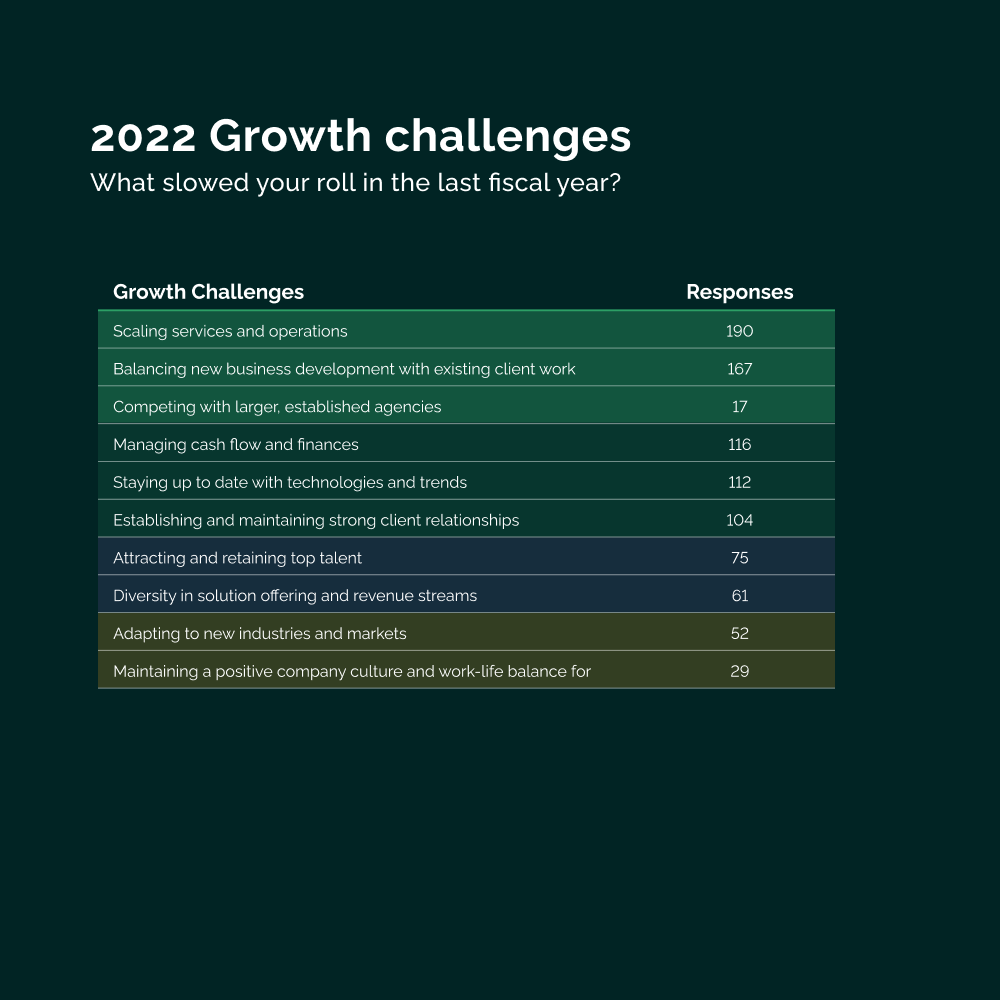
Key findings:
18%
of all agencies view scaling services and operations as their biggest growth challenge.
When polled about their anticipated growth challenges for 2023 and beyond, respondents ranked the top three in the same order.
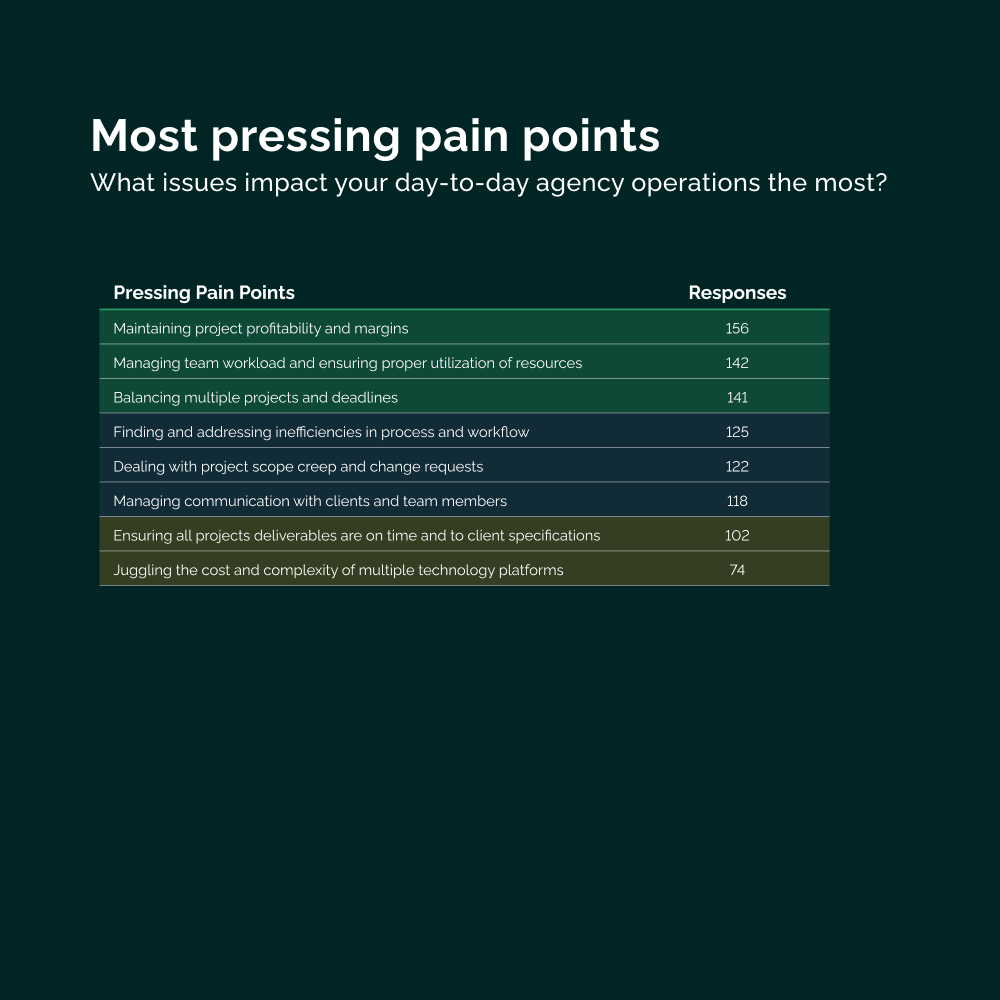
While it’s valuable to address longer-term challenges or risks to ensure future sustainability, pain points currently impacting day-to-day agency operations need immediate attention first. Once urgent obstacles are removed, the path forward is often more efficient and profitable. What is currently getting in the way of agency progress?
Key findings:
Agencies struggle most with the day-to-day logistics of optimizing financial performance and team productivity.
Deeper dive:
It makes sense that maintaining project profitability and margins is a key concern for agencies; 51% of them are using a project-based pricing model. Here’s the rest of the breakdown:
-
- 24% retainer-based pricing
- 22% hourly rate
- 3% performance-based pricing
💡 Pro Tip: Focus on delivery margins instead of overhead
Parakeeto CEO and Co-founder Marcel Petitpas suggests that agencies struggling with low profit margins tend to misdirect their focus on reducing overhead—even when overhead is already reasonable or lean. Instead, most agencies should focus their energy on their delivery margins to become more efficient at earning revenue and increasing profits.
How to Think More Profitably as an Agency
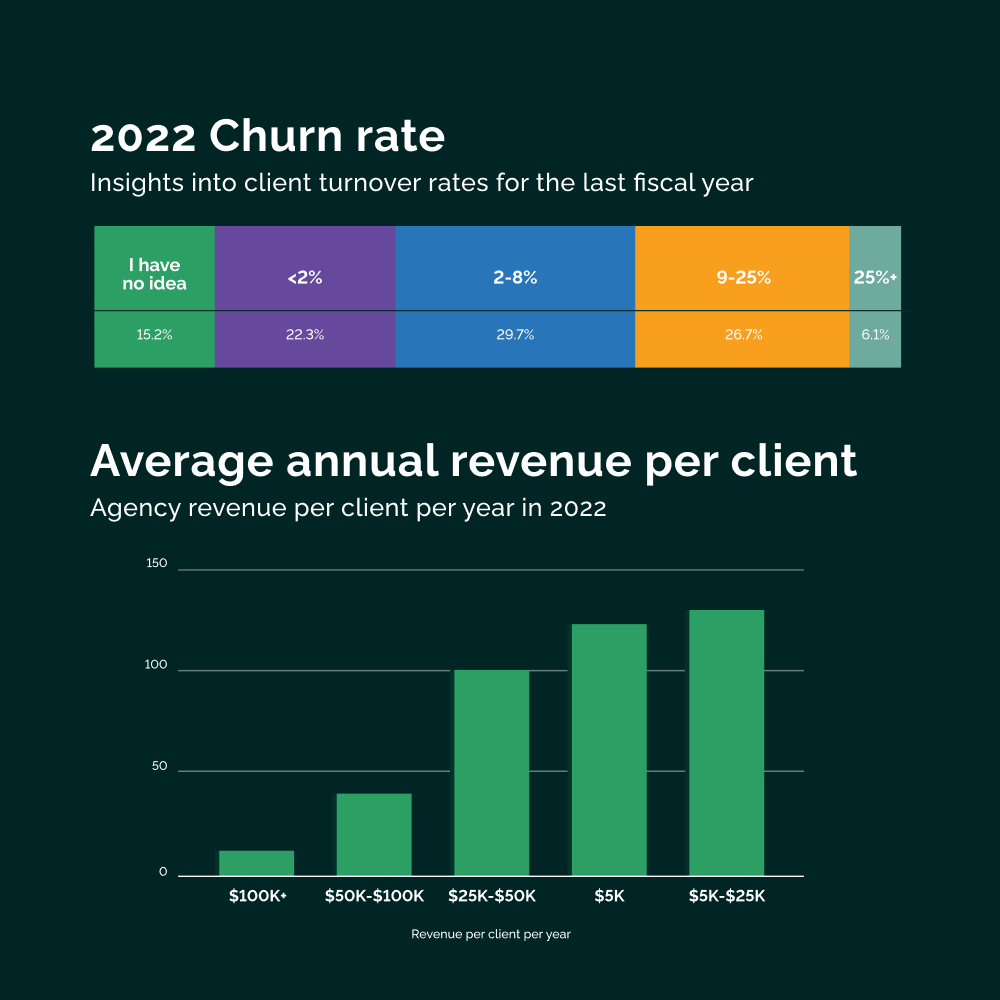
Churn rate is an important metric for any agency, especially going into 2023 and beyond. While losing clients directly impacts the bottom line, it can also impact an agency’s reputation and level of trust. With an industry in flux facing the potential of economic turbulence, having strong, long-lasting client relationships can be a critical lifeline.
Key findings:
2 – 8%
The majority of agencies experienced a churn rate between 2% and 8%.
15%
of respondents didn’t know their agency’s churn rate.
Deeper dive:
- 28% of agencies with an average client revenue of $25k or less have no idea what their churn rate is; only 8% of agencies who make over $25k reported not knowing.
- 51% of agencies with higher average client revenue (over $25k) also reported higher than average churn rates.
Often, churn can occur due to a lack of perceived value or misaligned expectations. Shifting your mindset from a vendor or salesperson to a trusted expert and guide can help build stronger relationships with clients and ultimately reduce churn. What other tactics can agencies employ?
💡 Pro Tip: Reduce churn by upselling
55% of survey respondents indicated that they do not consistently upsell or cross-sell as part of their sales process. This is a huge missed opportunity to reduce churn and deepen client relationships.
Our research on why agency clients churn shows that upselling has the highest impact on the lifetime of your clients at the three-month mark, indicating that it’s essential to check in with clients after 90 days to reevaluate. Conversely, 62% of clients that were not upsold within the first three months churned within 2 years.
Our analysis
Is low client churn always a good thing? Perhaps it’s time for a more nuanced approach. Churn rates between 2% and 8% are considered typical, and that’s where the highest percentage of our agency respondents fell.
However, it’s alarming that 15% of agencies are unaware of their own churn rate, with this figure being significantly higher (28%) among agencies with an average client revenue of $25k or less. This lack of awareness may point towards a gap in business acumen or the absence of essential tracking metrics, which could be impacting these agencies’ ability to retain clients and maximize profits.
Another trend emerged: 27% of agencies with annual revenue per client that equals less than $25k have churn rates under 2%. Are these agencies more committed to retaining clients at all costs? Especially when facing a potential recession, focusing on retaining clients at all costs may actually be detrimental to the agency’s overall profitability. To survive a recession, it’s important for agencies to reevaluate their client books to assess whether each client is worth the resources they are investing in them.
Subscribe to our newsletter
Explore industry tips, tricks, and how-to’s in our weekly content update.
SECTION THREE
🏔 Fuelling up for the climb: Sales and tools
Scaling an agency requires more than just talent; you need a solid sales strategy, an effective tech stack, and a keen understanding of the terrain.
As we continue our ascent, we’ll explore agency benchmarks related to the most effective channels for closing new business, challenges in the sales process, and where sales leaders are investing most heavily in 2023. Plus, in light of the previous data on client churn, we’ll also discuss how agencies are demonstrating their value through effective client reporting.
- A personal touch: Referrals and word of mouth are still effective methods for closing deals.
- Future-proofing sales: Many agencies are investing in sales enablement tools to support the future success of their sales teams.
- AI adoption and consolidation: AI can streamline workflows, but integrating it with existing tools can be challenging. Agencies prioritizing AI are also focused on consolidating their tech stack to ensure a high ROI.
Salespeople are so vital to the health and bottom line of marketing agencies we could have dedicated an entire agency benchmarks report to them. For now, let’s synthesize our most valuable learnings from the data.
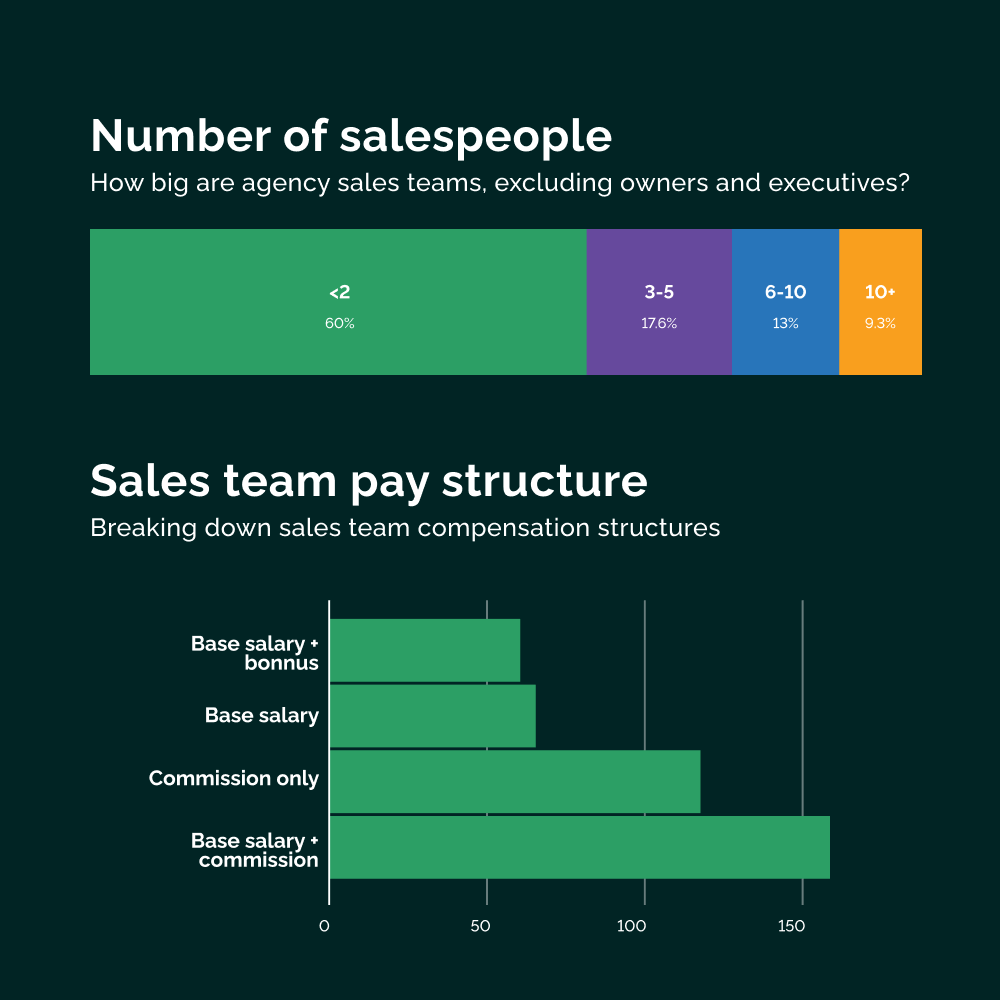
Sales team structure and annual revenue
- Commission only: Nearly all (91%) make under $1 million in annual revenue.
- Base salary only: 79% make under $1 million in annual revenue.
- Base salary + commission: 53% make between $1 and $3 million in annual revenue; 14% make over $3 million.
- Base salary + bonus: 74% between $1 and $3 million in annual revenue; 5% make over $3 million.
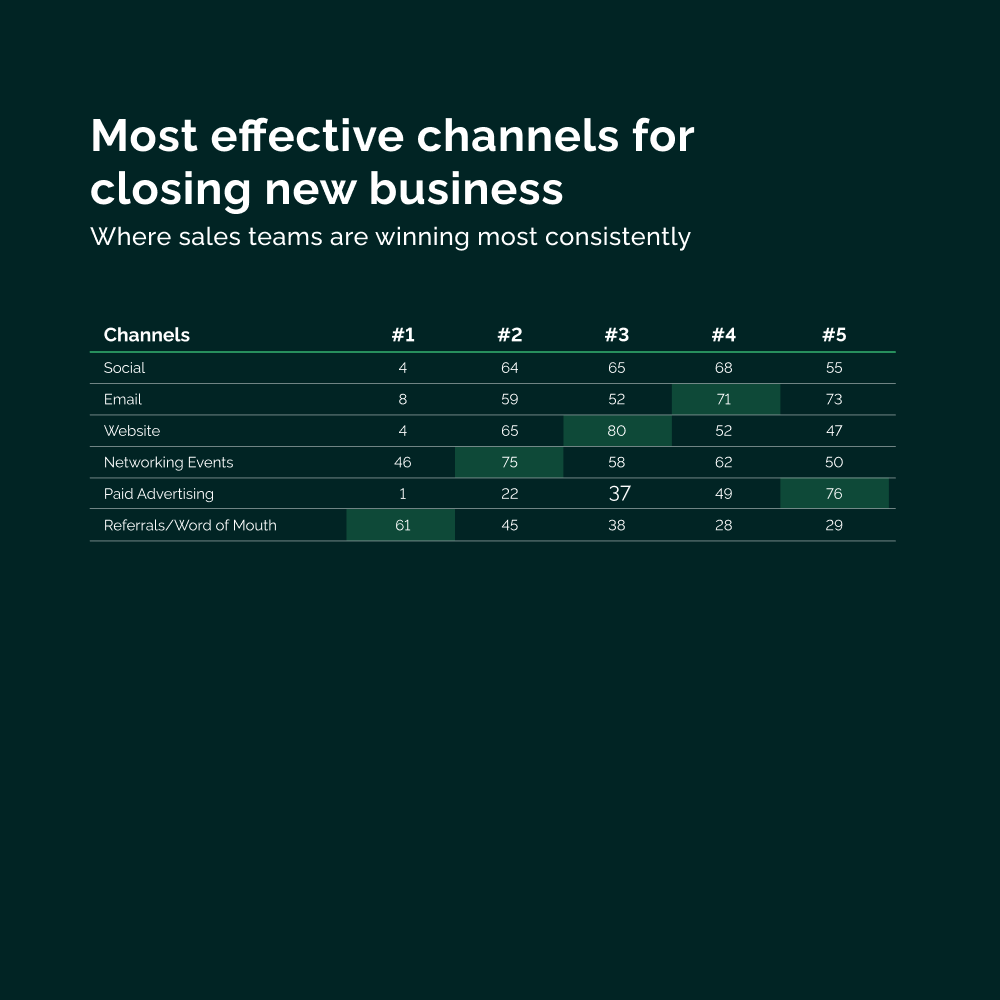
Key findings
78% |
of agencies have 5 or fewer salespeople. |
Referrals, networking, and websites are seen as the most effective channels for closing new business; email and paid advertising are considered the least effective.
Deeper dive
50% of agencies that made over $3 million in revenue last year currently employ three to five salespeople or more; 19% employ more than 10.
Our analysis
More revenue tends to correlate with more salespeople, with agencies that have scaled past $3 million in annual employing three to five reps. Data on sales team pay structures suggest that the highest performing teams need some measure of stability in the form of a base salary, coupled with a bonus or commission structure to encourage motivation, drive, and a direct correlation between performance and earnings.
Despite new technologies and digital marketing channels, tried-and-true methods like referrals and word of mouth continue to be some of the most effective ways for salespeople to close new deals in the agency space.
While social media was perceived as the least effective channel for closing new business, some might argue that social media can function as a hybrid of word of mouth and networking. According to sales expert Robert Knop, the key is not to reinvent the wheel, but to move the racetrack. In other words, to adapt traditional methods to work in tandem with new techniques like social selling on LinkedIn.
According to these digital marketing agency statistics, a relatively small number of agencies identified handling objections (4%) and closing the deal (8%) as the most challenging aspects of the sales process. The real hurdles to overcome, it seems, are all the steps required to get to those crucial points.
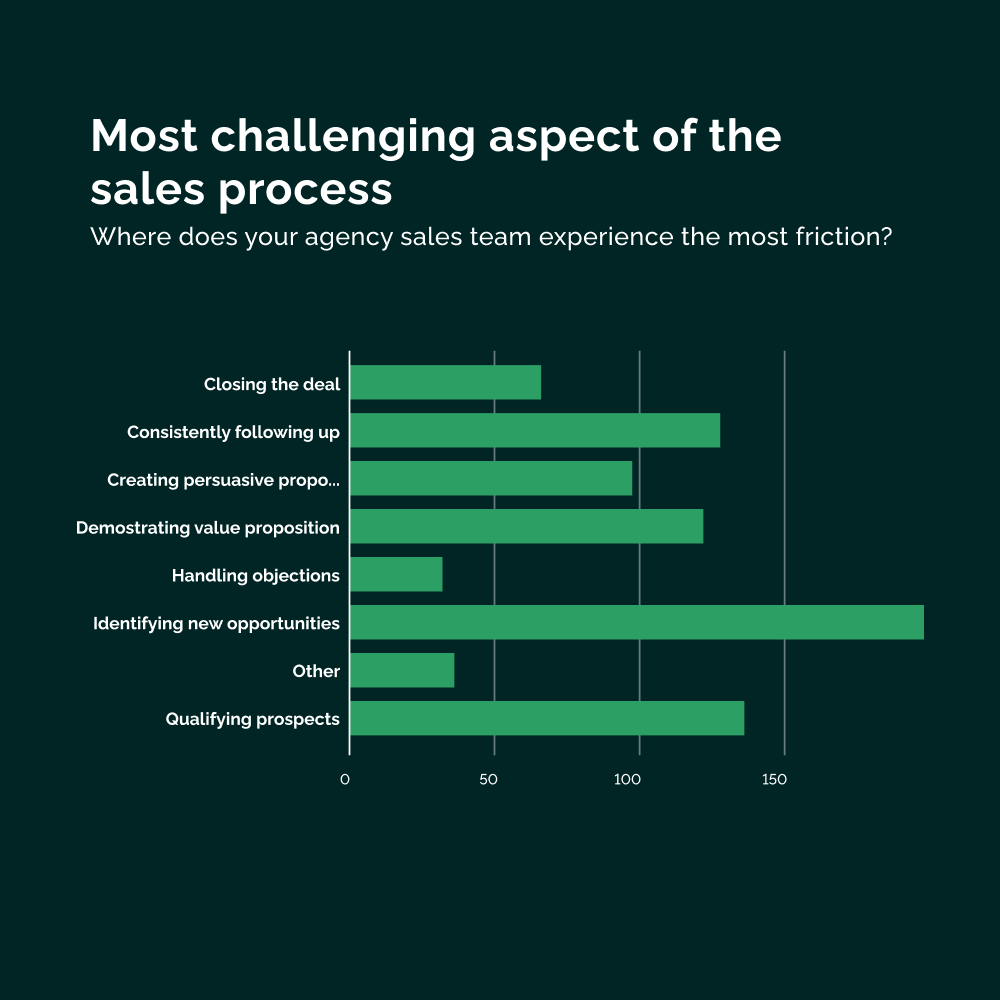
In the “Other” category, agencies most frequently identified the length of their sales cycle as their biggest challenge, followed by having product and service features that meet market demand.
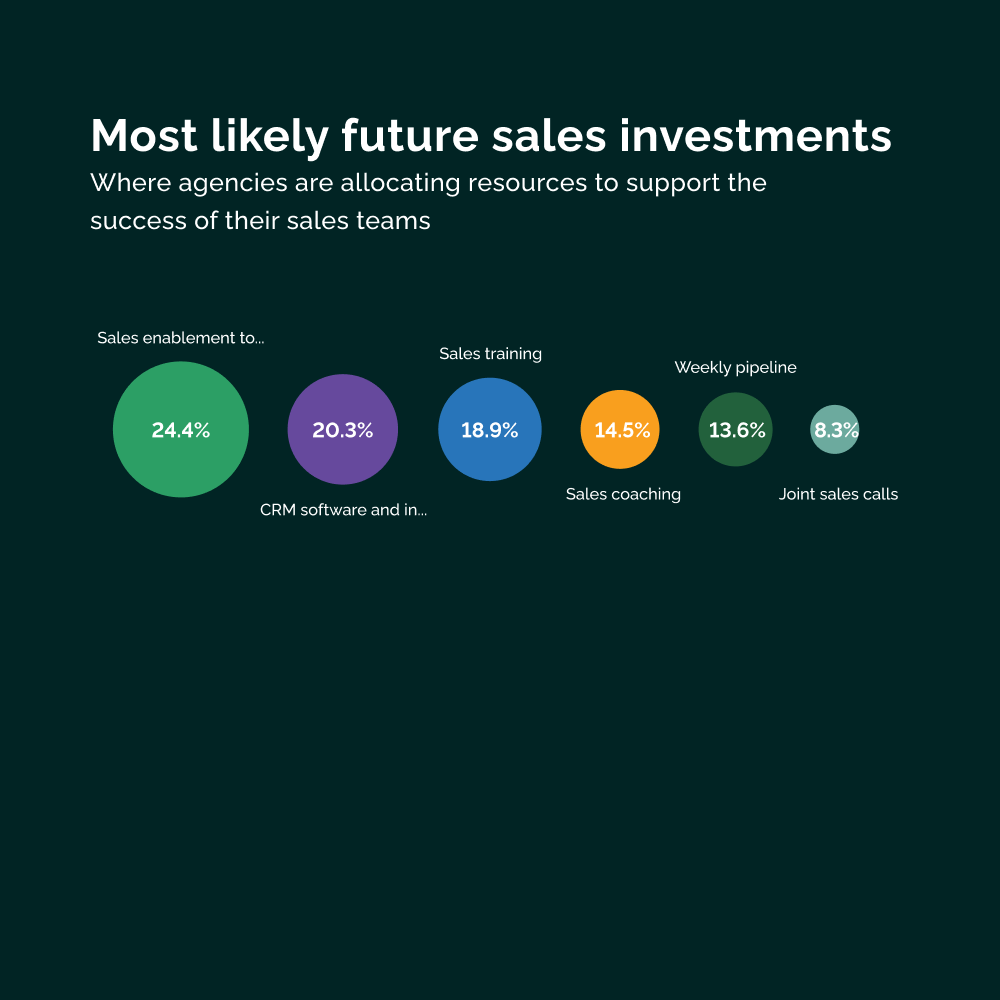
Key findings
44% |
of respondents would choose to equip their sales teams to be successful more autonomously through sales enablement tools and CRM software and integrations. |
Our analysis
According to these agency benchmarks, there appears to be a clear link between the challenges agencies face in their sales processes and how they plan to mitigate them. The main hurdles include identifying new opportunities, qualifying prospects, and following up consistently. To navigate these hurdles, sales teams must not only identify potential leads but also effectively evaluate their potential and ensure sustained engagement.
It’s no surprise that a significant portion of agencies—44% of respondents, in fact—are looking to empower their sales teams through sales enablement tools and CRM software and integrations. Such tools can automate and streamline various aspects of the sales process, allowing sales teams to work more autonomously, efficiently, and effectively.
The trend away from more traditional sales investments such as weekly pipeline reviews (14%) and joint sales calls (8%) seems to underscore the challenges agencies face with time management. The relatively low priority given to these activities may indicate a growing recognition that the key to success lies not just in intensive oversight and collaboration but also in leveraging technology to optimize sales processes.
💡 Pro Tip: Identify new opportunities with personalized outreach
Effective email outreach is never “cold” outreach. Give prospects something helpful upfront and personalize your message to show that you’ve put in real effort.
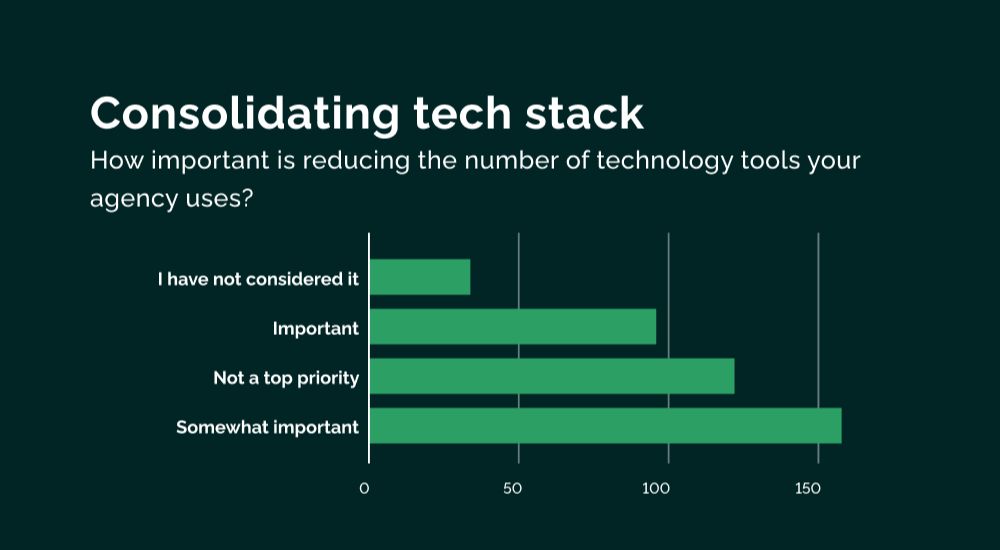
As agencies grow, so does their collection of software and tech tools to manage day-to-day operations. But more tools can mean more problems. Are they all working together seamlessly? Is there too much technology to manage? And in today’s market, is it still a priority to simplify and streamline the tech stack? Our agency benchmarks set out to answer these critical questions.
Key findings
62% |
of agencies recognize the need to reduce their tech stacks in some capacity. |
Deeper dive
Agencies that are committed to AI view tech stack consolidation as a priority (60%).
Our analysis
Agencies committed to implementing AI are more likely to prioritize reducing their tech stacks, which might seem counterintuitive at first. While AI can streamline workflows, it can also introduce complexities that can make integrating with existing software and tools a challenge. By focusing on consolidating their tech stack, these agencies seem keen on ensuring their investment in AI has a high ROI by making sure it’s properly integrated and utilized.
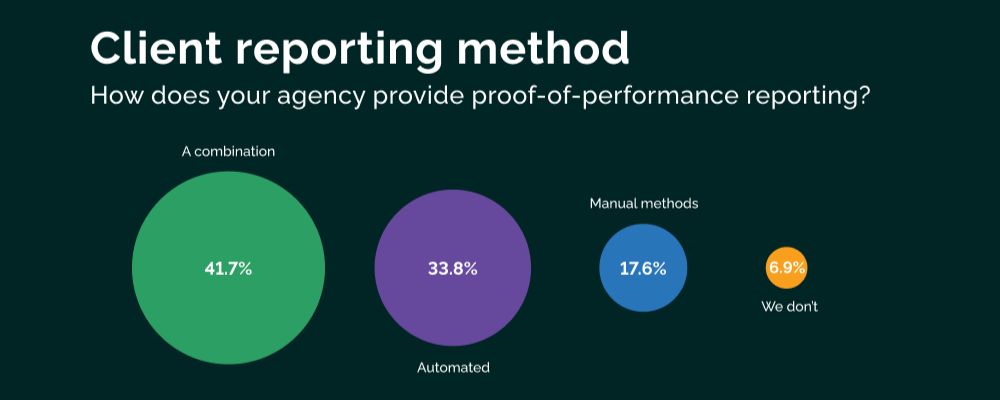
From key performance indicators (KPIs) and metrics to recommendations, client reporting has long been considered a crucial aspect of the agency-client relationship.
Our survey found that while some agencies provide regular reports to clients using automated tools that provide real-time data, others struggle to keep up with the demands of manual reporting and may need to adjust their processes to keep pace with competitors.
Key findings
The majority of respondents are still cobbling together a mix of manual and generated reports.
A significant portion of agencies still use exclusively manual methods, such as spreadsheets, to update clients.
7%
of respondents don’t provide client reports at all.
Deeper dive
- 43% of agencies provide their reporting on a monthly basis.
- 25% of agencies using manual reporting methods only update their clients as needed.
- 44% of agencies using automated reporting with real time data update their clients daily or weekly.
SECTION FOUR
🏔 Rallying the Roster: Resellers, Fulfillment, and White Label
To adapt to current market conditions and position themselves for growth, agencies will need to update their climbing strategies to leverage a new roster of resources.
This section of agency benchmarks look at how agencies can capitalize on a variety of external resources and outsourcing partnerships to optimize their existing teams, including reselling and white labeling. By exploring these options, our digital marketing agency statistics indicate that agencies can add additional value to their clients and position themselves for a successful long haul.
- Delegating the demanding: Outsourcing is common for roles that demand technical expertise, require constant monitoring, or are ever-evolving.
- Leveraging resellers: Over 60% of agencies use both white-label and external vendors.
- Quality quandary: Content creation is difficult to outsource due to the need for insider knowledge.
- Resource constraints: Smaller agencies managing fewer than 100 clients might lack the resources to manage vendor relationships or integrate third-party products.
Scaling an agency is a delicate balancing act. How do you deliver high-quality work at scale without overburdening your team or ballooning the cost of in-house resources? According to our agency benchmarks, that’s where outsourcing comes in. Decisions on how much to outsource and which services make good candidates for outsourced fulfillment depend on various factors, including your agency’s strengths, capabilities, niche, and resources.
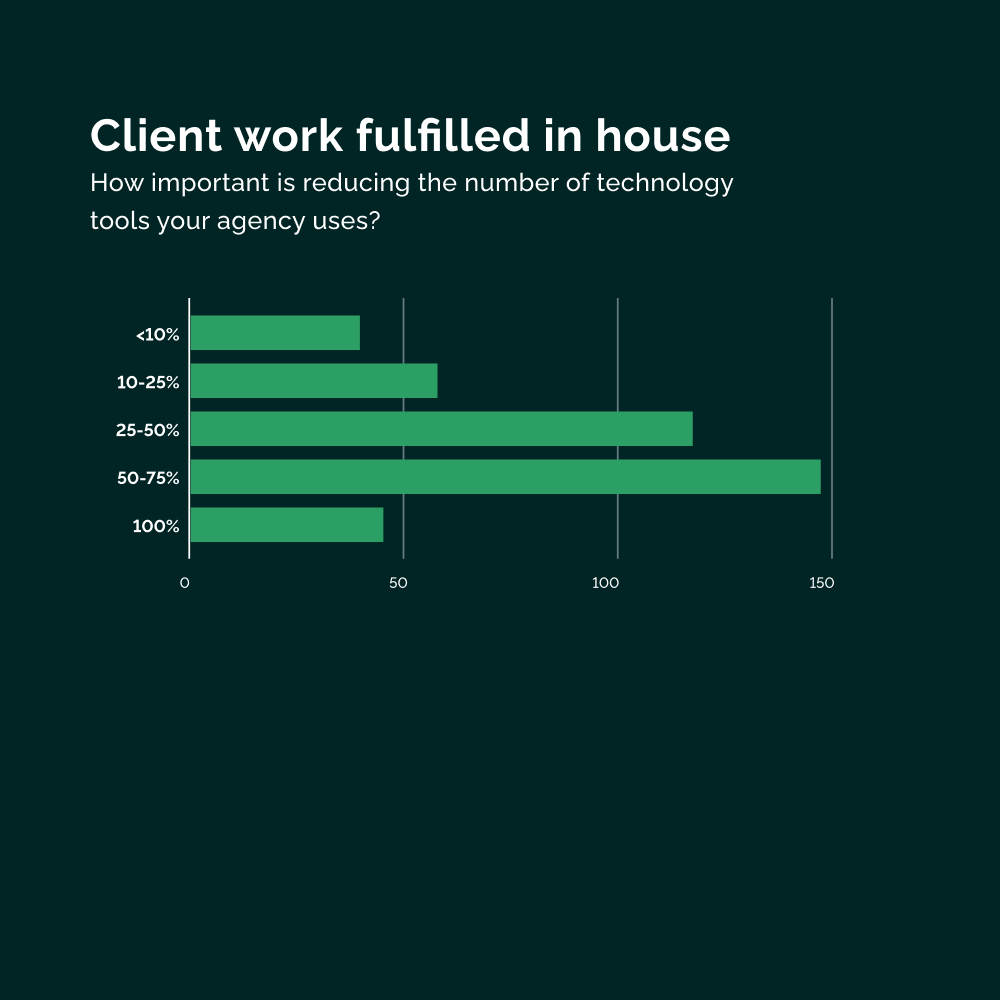
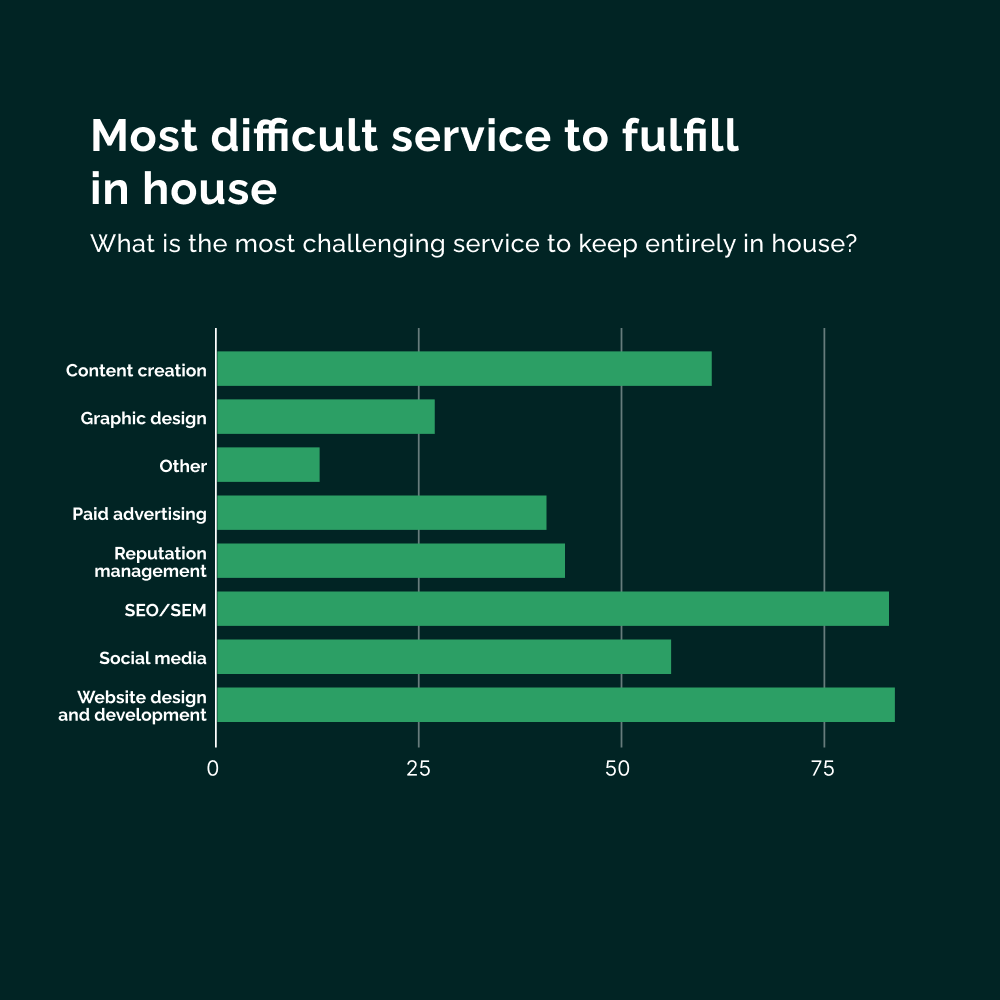
Key findings
1/4
Approximately one-quarter of agencies complete less than 25% of their client work in house.
Website design and development, SEO/SEM, and content creation are the three hardest services to fulfill in house.
Deeper dive
Agencies that don’t use AI or are just beginning to use it said content creation is the most difficult service to fulfill in house.
Our analysis
Approximately one-quarter of agencies complete less than 25% of their client work in-house, highlighting the fact that agencies are leveraging external resources. Outsourcing can be a savvy strategy driven by various factors. Some include the need for specific technical skills, adapting to rapidly evolving industry trends, and the strategic decision to focus on core areas of strength.
The tasks proving to be most challenging for in-house execution include website design and development, SEO/SEM, and content creation. Website design and development, along with SEO/SEM, require constant updates and highly specialized skills. It’s challenging to keep up with changes in algorithms, technological developments, and industry trends, making outsourcing a logical solution.
Content creation, despite seeming straightforward, can be nuanced and complex. It calls for an intimate understanding of the brand, its industry, and the target audience. Agencies specializing in law firm SEO or operating in the healthcare marketing space, for example, will have to produce content that demonstrates insider expertise about complex industries in order to add value to a niche audience. Understandably, then, it can be difficult to bring in third parties to do this work.
Interestingly, agencies that are new to using AI or don’t use it at all cite content creation as the most difficult in-house service to fulfill. This finding underscores the potential of AI to significantly streamline content generation, from topic ideation to basic drafting, offering an avenue for agencies to explore for future optimization.
As agencies seek to provide a full suite of services to their clients, white-labeling and reselling solutions from other vendors becomes an attractive option. And according to our digital marketing agency statistics, the majority of agencies are taking advantage of these opportunities.
Recommended Reading: White label for agencies: What services and products to white label and why
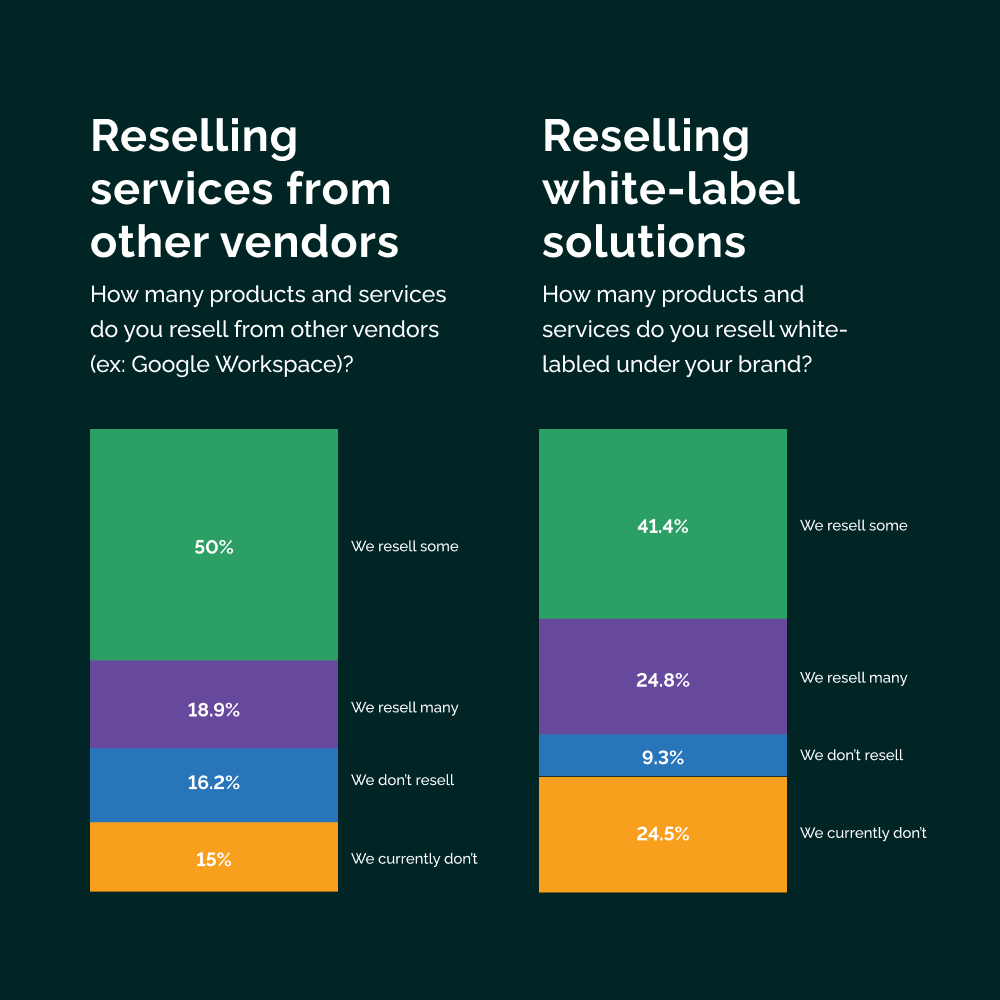
Key findings
66% |
of agencies resell white-label solutions under their brand, while 69% of agencies resell solutions from other vendors. |
Deeper dive
74% of agencies that said they do not resell vendor products and services manage fewer than 100 clients.
Our analysis
The majority of agencies that don’t use a reseller business model in some capacity have one thing in common: They manage fewer than 100 clients. These smaller agencies might be at the point where they are not yet focused on scalability. They might currently have the bandwidth required to build custom solutions for clients each time—but this will only bring them so far.
It’s also worth noting that agencies managing fewer than 100 clients likely have a smaller team with fewer resources. This can limit their ability to manage vendor relationships and integrate third-party products or services into their workflows without a single system of record.
 Vendasta value: Marketplace product catalog
Vendasta value: Marketplace product catalog
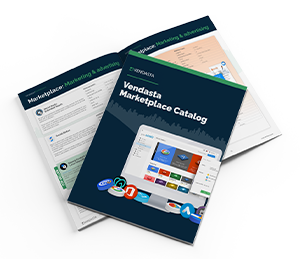
SECTION FIVE
🏔 Navigating the frontier: AI, recession, and the future of agencies
As we look to the future, agencies face both unprecedented challenges and exciting opportunities.
The rise of AI has already disrupted the industry, encouraging agencies to evolve their approach and embrace its power. In our concluding agency benchmarks section, we’ll examine just how heavily agencies are investing in AI technology, to what end, and how respondents perceive its impact on the future of their businesses.
It’s worth noting that the potential for an economic downturn is still an uncertainty on the road ahead. While it remains to be seen whether a full-blown recession will materialize in 2023 or 2024, the economy is cyclical. The present moment presents an opportunity for agencies to plan and prepare for the future, regardless of the current circumstances. How agencies respond now can be insightful and predictive for their future success.
- Artificial intelligence, real revenue: Agencies making over $1 million annually invest more heavily in AI.
- Democratizing technology: AI is becoming more accessible and affordable, so smaller agencies can benefit too.
- Recession insights: Agencies are more likely to adopt automation and efficiency tools than cut headcount, even in the face of economic uncertainty.
AI is a hot topic for agencies. Still, our agency benchmarks survey results show that well over half of them are relatively new to it. However, this doesn’t mean that they don’t understand the importance of increasing their investments as it becomes a more significant tool in the agency landscape. Only 11% of agencies surveyed do not use AI at all, reflecting the reality that AI will continue to have a growing impact on the market in the coming years.
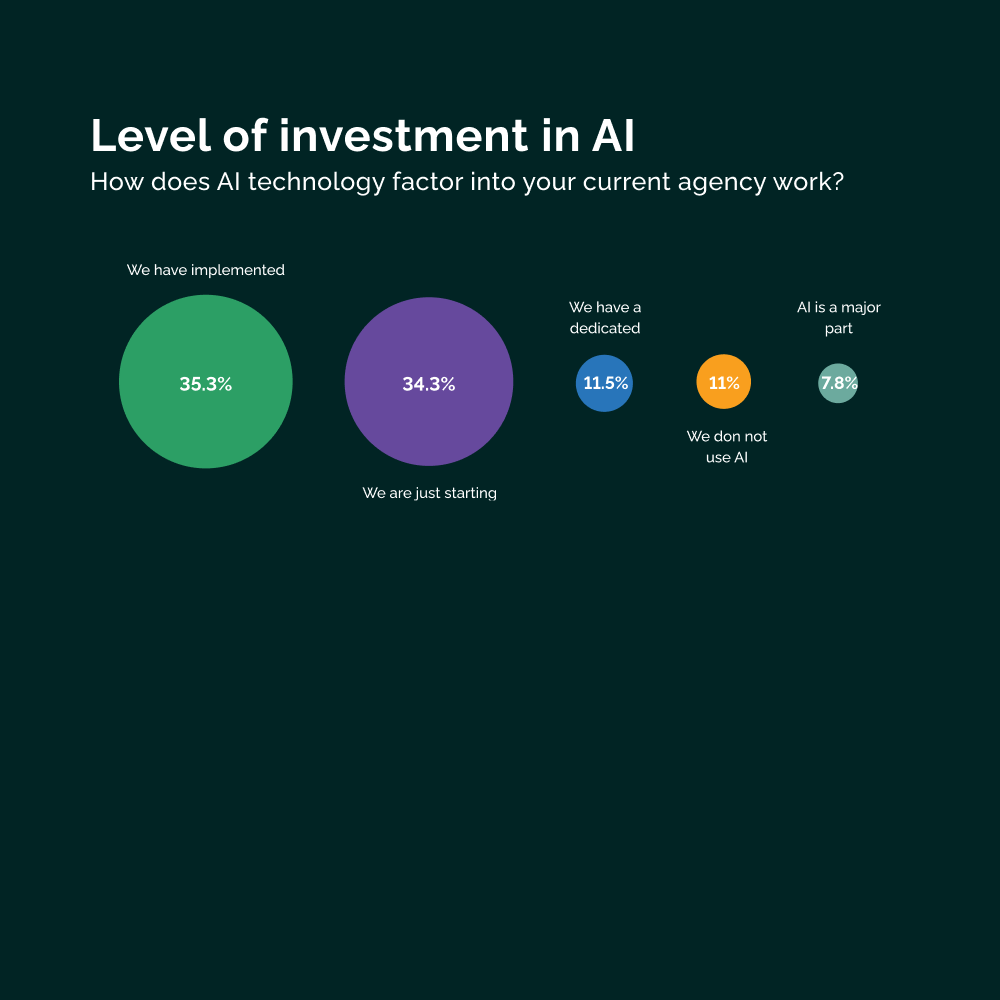
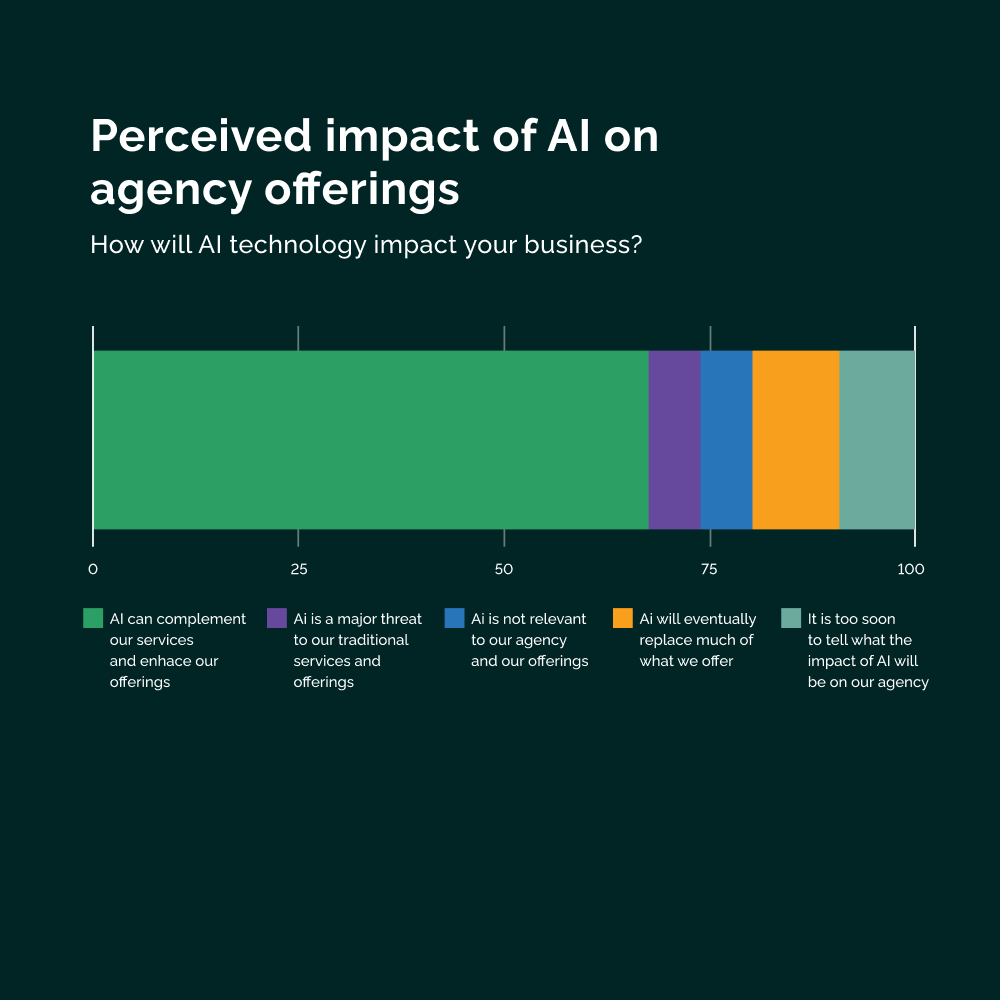
Key findings
69%
of agencies are very new to AI.
2/5
agencies are using AI frequently.
16%
were either on the fence or thought AI didn’t affect their operations.
Deeper dive
Only 6% of agencies making between 1$ and $3 million in annual revenue do not use AI at all.
Our analysis
If agencies want to know what their counterparts making over $1 million annually are doing differently, our digital marketing agency statistics indicate that the answer is investing more heavily in AI. Of course, it can be a sort of chicken and the egg scenario: Are these agencies able to invest more in AI because they have more resources, or are they making more money because they’ve invested in AI?
While it’s tough to know for sure, what’s clear is that AI is rapidly becoming more accessible and affordable, so even smaller agencies can reap the benefits.
While only 7% of agencies surveyed reported that they would keep things business as usual during a recession, it’s clear most are preparing to adjust to potential shifts. The good news? Those potential adjustments do not typically include cutting headcount (5%). Whether or not a full-blown recession happens, it’s important to prepare for the cyclical nature of these types of economic downturns. Developing a game plan now could make it easier to not only weather any future storms, but even increase sales during a recession and grow. So what is the most likely course of action?
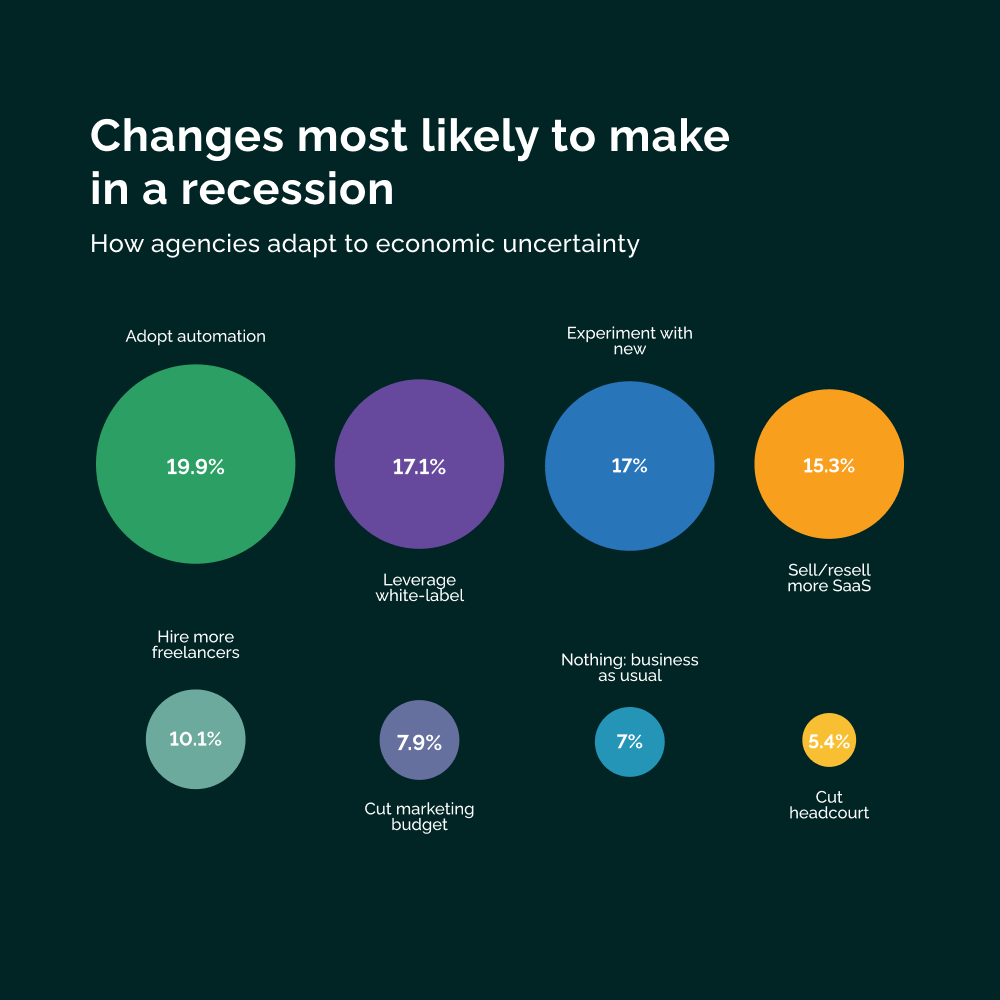
Key findings
Agencies are not interested in cutting marketing budgets, hiring more freelancers, or cutting headcount to compensate for an economic downturn.
Our analysis
If your clients don’t let you go, you won’t have to let your staff go. It’s hard to tune out the industry-wide layoffs, especially in the technology space, so it might seem as though cutting staff might seem like an inevitable move for agencies facing economic uncertainty. But agency benchmarks show that agencies are more likely to adopt automation and efficiency tools, or resell more SaaS solutions, than to cut headcount. It makes sense—downsizing can be a band-aid solution and doesn’t address underlying issues. It’s also important to note that cutting headcount can backfire if things bounce back quickly and agencies suddenly find themselves understaffed and struggling to keep up with demand.
On-demand webinar: Weatherproof your agency
If you’re looking to weather-proof your agency, Vendasta helps partners optimize their current team’s performance for sustainable growth— without the need to downsize. Agency partners are equipped to weather economic challenges with unified tools, teams, and clients.
CONCLUSION
A complex and rapidly changing landscape
The 2023 Agency Insights Report reveals a complex and rapidly changing industry landscape.
As the world continues to shift and evolve, agencies will need to stay nimble and adapt quickly to meet the changing needs of their clients. But given the resilience and innovation that characterizes the industry, agencies are well-positioned to lead the way forward and drive growth for businesses of all types.
By staying focused on customer-centric thinking, balancing profitability and growth, and remaining open to new technologies and approaches, agencies can continue to thrive in the years to come.
💡CMO perspective: Tactics to navigate a recession
I believe that success in any business starts with customer-centric thinking. To operate efficiently and effectively, even in times of recession, we must understand how our customers’ needs are changing and be prepared to adapt quickly.
In 2023, agencies have reached another moment that will call for quick prioritization, adapting to how AI is changing the industry and affecting customer expectations. To ensure our continued success, we regularly evaluate our ideal customer profile and adapt to these market changes.
At times of economic uncertainty, it’s more important than ever to stay focused on the metrics that matter and to be prepared to take risks when necessary. While the future of agencies is not without its challenges, with resilience and innovation, they are poised to lead the way forward and forge ahead.

Find your footing and climb higher with Vendasta
The 2023 Agency Insights Report reveals key challenges in the industry:
- A fiercely competitive and saturated market
- Pressing concerns about project profitability and margins
- Difficulties in competing with larger, established agencies
Vendasta can address these challenges while unlocking sustainable growth by unifying your tools, team, and clients under one comprehensive platform.
This includes significant differentiators like:
- Streamlined data and communication processes
- Access to a wide range of re-sellable products and services
- A rebrandable client dashboard with automatic reporting
As you embark on your agency’s ascent, you don’t have to face it alone. With Vendasta as your climbing partner, you can unlock the potential to scale your agency’s operations, streamline your workflows, and achieve remarkable growth while saving valuable time and resources.
Empower your agency to operate efficiently, meet diverse client needs, and deliver extraordinary customer experiences.
Let’s chart the path to growth together.
Domenica Martinello
Domenica Martinello is a Content Marketing Specialist at Vendasta and her diverse career has revolved around an appreciation for storytelling, education, mentorship, and facilitation. She has taught English Literature to college students, published a book, worked in EdTech, and cut her teeth at an inbound marketing agency. Off hours, you can find her reading, writing poems, and playing with makeup (not all at once).







